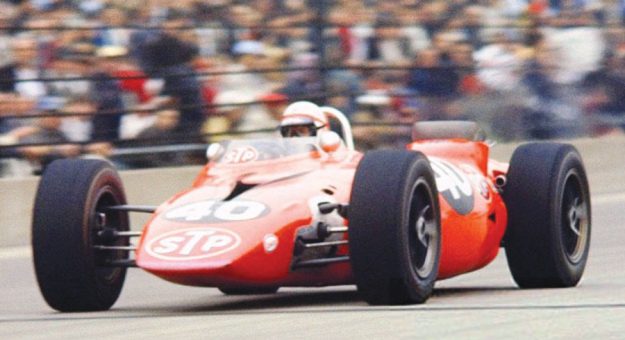In more than a century of Indianapolis 500 history, few cars have produced the controversy that Andy Granatelli’s turbines did.
Although they competed at Indy only twice, they generated a maelstrom of publicity that transcended auto racing and still generates passionate debate 55 years later.
The first of those remarkable machines appeared in 1967. Driven by American racing icon Parnelli Jones, the car nearly won the 500. However, as dominant as that combination proved to be, its coming together was quite unintended.
“In 1963, I took one of Andy’s Novis out for a run at the speedway,” related Jones. “I was shaking it down for Bobby Unser and I drove it faster than anyone ever had. After that Andy was always after me to drive for him.
“One day he called and asked me to come to his shop in Santa Monica,” continued Jones. “He said he had something to show me. I went in and there sits this unusual turbine-powered, four-wheel-drive car. Andy had originally wanted to run a Novi engine in it but got interested in turbines. I didn’t think it was going to work and I told Andy so.”
Despite Jones’ lack of faith in the concept, Granatelli kept after him to at least try the turbine. Finally, Jones told him, to get him to shut up as much as anything, that he’d be testing at Phoenix and if the car was there, he’d shake it down.
Granatelli took the car to Phoenix.
“It took me a few laps in the thing to get used to the throttle delay,” Jones recalled. “It was about three seconds. Then, it surprised me because it actually started feeling pretty good. I ran some very quick laps. Then, Granatelli was really after me.
“But Vel Melitech and I had started our own team and I felt committed to driving one of those cars. Well, Granatelli kept on, asking me how much it would take to get me in the car. He told me to name a price.
“To be honest, our car didn’t feel that great,” Jones added. “So I called Andy’s bluff and gave him a number that I thought he would turn down. I told him I would drive his car for $100,000. That was a lot of money then, but I’ll be dammed if he didn’t agree.
“I was supposed to get the money after I qualified, but by then Granatelli was holding out. I finally had to pay my manager, Chuck Barnes, $500 to collect it,” chuckled Jones.
Financial disagreements aside, at Indianapolis the turbine performed flawlessly and promptly became a lightning rod for controversy. The target of scathing criticism by drivers of conventional cars, some claimed the heat waves from the turbine distorted their vision at speed.
Others insisted when Jones activated the air brake flap, it distracted them and they couldn’t see around it.
Jones qualified sixth, his worst starting position for a 500. He was immediately accused of sandbagging.
“I wasn’t,” insisted Jones. “Those other guys were practicing and qualifying with light fuel loads, using nitro, while I was basically running the thing in race trim. In practice I could outrun those guys through the corners, but halfway down the straights I would be out of steam and they’d blow right past me. That’s all it had.”
Jones knew, however, that would change when everyone else detuned their cars for the race. And Jones devised a plan to take advantage of that.
“After the drivers’ meeting,” Jones said, “I asked Gordon Johncock what he was going to do when we got the green. He was in front of me on the outside of the front row. Gordy said he was going to drop down to the inside going into one.
“So I decided I’d do what Jim Hurtubise did during the ’63 race. He’d dropped back at the start, then pulled to the outside and passed a half dozen cars, including me, to lead the first lap. So when Gordy dove down, I stayed high and zipped around everyone,” Jones explained. “Mario (Andretti) gave me the finger when I waved as I went by him.”
Jones dominated, leading 171 laps before a transmission bearing failed four laps short of the win.
Parnelli’s ’67 run encouraged Granatelli to return with a fleet of turbines in 1968. A turbine nearly won again and with that, USAC legislated turbines out of existence.
